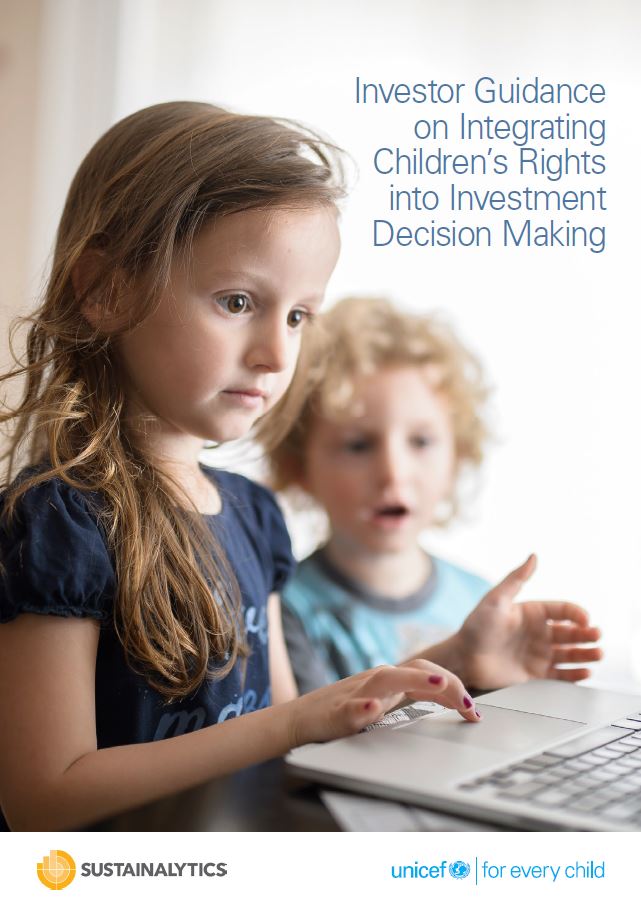Imagine there was a stakeholder group that formed a third of the global population and was pertinent to business in various ways: as customers, as employees’ family members, and as key participants in local communities and in society at large. These people would be guaranteed to run the world in the future. Almost everyone would know and be related to representatives of this network, and many would consider them the most important people in their lives. You would expect companies and investors to assess the impact they have on these powerful influencers and try to capitalise on the related opportunities, but that is rarely the case. This is because the group I’m talking about is children. When it comes to incorporating children’s rights and needs into business and investment strategies, there is still a long way to go given their number and potential.
Making the invisible visible
Before they grow up to take over the world, children are often the invisible, yet most significantly affected group, with unique vulnerabilities and needs. Business activities that have no negative impact on adults may be very harmful to children’s rights and well-being. Accordingly, human rights policies and impact assessments do not necessarily capture the linkages to children. Indeed, while the association between business and human rights is becoming increasingly acknowledged and addressed by companies and investors alike, the attention to children’s rights specifically is still rather low.[i]
To help investors better understand the relevance of children’s rights for their analyses and address the related risks and opportunities, Sustainalytics and UNICEF recently published Investor Guidance on Integrating Children’s Rights into Investment Decision Making. Our aim was to provide investors with a practical toolkit to help raise their awareness of the impacts of business activities on children’s rights when developing their responsible investment and active ownership strategies. Apart from illustrating why and how children intersect with investments, the guidelines outline the practical steps that investors can take to further children’s rights and provide a set of indicators and criteria that can be used as discussion points and measurement tools in company engagement.
Much more than child labour
One aspect we wanted to highlight in the guidance is the breadth of consequences business can have on children’s rights. When considering children’s rights in the context of business, many immediately think of child labor. Granted, child labor has frequently been in the media spotlight and many companies have learned the hard way about the significance of this issue. Because child labor remains a serious problem in many industries and countries, companies and investors must continue to address this topic. Indeed, the issue remains part of several of Sustainalytics’ engagement discussions. But child labor is not by any means the only aspect of children’s rights that has relevance to companies[ii], and it is essential to broaden and deepen the understanding of the concept accordingly.
For example, company activities may intersect with children’s rights via the nutritional value of the foods they produce, the robustness of their privacy policies or the design of their products. Relocations of surrounding communities may negatively affect the right to education, air pollution is more harmful to children than adults[iii], and employees’ working conditions may have detrimental consequences to the wellbeing of their families. Marketing of any kind may affect young minds in unintended ways and the fact that one in 500 employees consumes child sexual abuse material on their work computer[iv] should give cause for companies in all industries to review their IT policies.
However, children should not be seen only as risks, victims and passive recipients. In fact, companies can play an instrumental role in empowering and educating children and supporting the fulfilment of their rights. This could also lead to profit opportunities and a chance to build brand recognition and appreciation among children and parents. Although not everyone agrees, children are consumers and through appropriate products and services, marketed in a responsible manner, companies can both have a positive impact on childhood development and tap into a lucrative market.
Materiality and investor relevance
It is safe to say that a failure to mitigate and manage child-related risks – not to mention missing out on the opportunities – can have material consequences to companies, also making this very much a pertinent issue for investors. The materiality of children’s rights is one crucial aspect that should and will be explored further in order to accelerate this topic’s perceived importance and its strategic standing. Regardless, universal ownership, responsible investment, and fiduciary duties are all undeniably linked to ensuring that children are holistically appreciated and accounted for. Likewise, anyone seeking to align their practices with the Sustainable Development Goals should note the framework’s numerous direct and implicit references to the importance of the fulfilment of children’s rights – far beyond the elimination of child labour – in the 2030 agenda.
I am confident that this is an area where businesses will be increasingly expected to demonstrate responsible behaviour by the public and policymakers alike. Accordingly, investors would also benefit from assessing their exposure and proactively encouraging investee companies to stay ahead of the curve. Corporate actions can have instant as well as long-reaching impacts on the development and well-being of their youngest stakeholders, for better or for worse. Therefore, engaging companies to adapt their practices and offerings to the needs of the child has the potential to influence what kind of consumers and digital citizens, and ultimately future employees and decision-makers, the next generation will grow up to be. And that, if anything, is responsible investors taking a long-term approach.
Sustainalytics and UNICEF recently hosted a webinar covering the guidance document and providing practical insights from the investor perspective.
Sustainalytics also offers thematic engagements focusing on Child labor in cocoa and Children’s rights in media and marketing respectively – contact your client advisor or contact us to find out more.
Sources
[i] Global Child Forum and GES International, https://www.globalchildforum.org/wp-content/uploads/2018/03/Investor-Insights_Global-Child-Forum-180328.pdf, last accessed 17 September. GES International was acquired by Sustainalytics on 2 January 2019.
[ii] For example, Children’s Rights and Business Principles, launched by the UN Global Compact, UNICEF and Save the Children in 2012, details in a very practical manner the full range of issues that companies should address in order to ensure respect and support for children’s rights.
[iii] WHO https://www.who.int/air-pollution/news-and-events/how-air-pollution-is-destroying-our-health/children-and-air-pollution, last accessed 17 September 2019
[iv] Netclean https://www.netclean.com/netclean-report-2018/, last accessed 17 September 2019.





